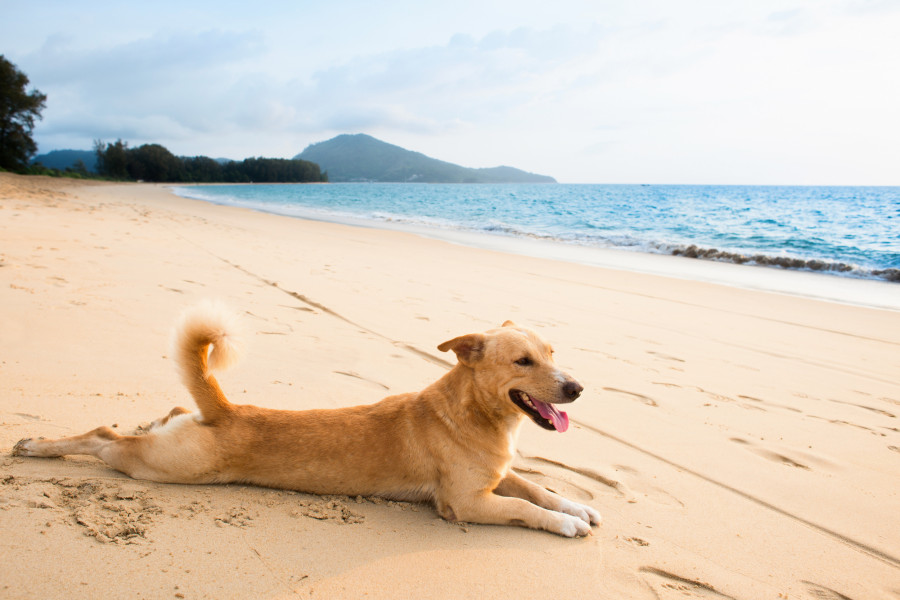Signs of Overheating in Dogs

As the weather warms up, it is exciting to be able to finally go outside without bundling up and enjoy the sun with our dogs. There is nothing better than a game of fetch on a sunny day! And of course, sunshine gives your dog important nutrients like vitamin D. But like everything else in life, you have to make sure your dog isn’t having too much of a good thing. Too much sun, and your dog may overheat, causing heat stroke and even death. Watch for these signs of overheating in your dog to keep him safe and happy in the warmer months.
Excessive Panting
Dogs do not sweat like we do, making it easier for them to be affected by the heat. Panting is the only way they have to really cool down, and it’s not a very effective system. A dog that is panting heavily may be getting too warm. Look for the tongue being curled up more than usual and your dog not wanting to move. If this happens, it’s a sign it’s time to go in, get some water and relax in the temperature-controlled house.
Bright Red Tongue
Most dogs have light red/pink tongues. But when they start to overheat, their tongue will change to a bright red and may even look swollen.
Bright Red or Blue Gums
If your dog has a black tongue, you can also look at his gums to see if he is getting too warm. Again, normal gums are a pale pink/almost whitish colour on most dogs. When they get too hot, they will turn bright red or blue.
Rapid Heart Rate
Check your dog’s heart rate. You can feel a dog’s pulse on his left side behind the front leg, or inside the top of his hind leg, about mid-thigh. If his heart rate is faster than normal, he needs to cool down.
Vomiting
Dogs who are having trouble in the heat may also throw up. If you see your dog vomiting after being outside, it could be a sign he has had too much sunshine. Some dogs may also have diarrhea.
Sticky Saliva
Is your dog’s saliva sticky instead of slobbery? This can be a sign of overheating or dehydration.
Lack of Coordination
If your dog is suddenly acting dizzy or having trouble getting up or walking normally, they could be suffering from heat exhaustion.
Collapse or Seizures
If your dog is severely overheated, she may collapse or go into a seizure. Both can lead to death.
If you see any of these signs, take your dog somewhere cool immediately and call your vet. It’s important to cool them off correctly, according to your vet’s instructions. You do not want to cool them off too quickly by spraying them with a cold hose, for example, this can shock their system! Putting a cool damp towel over their head or stomach is better. Then get further instruction for your vet. They may need to see your dog right away to give them fluids.
Brachycephalic breeds and breeds with barrel chests are more susceptible to heat stress. Also, longer haired dogs are more sensitive to heat than short haired dogs. In general working breeds like kelpies will have a much higher tolerance to running around on hot days. Basically, don’t expect your French bulldog to run around with a Kelpie down at the dog park on a hot day.
It should be noted that your dog may not want to eat much in hot weather, and that’s okay. It doesn’t mean they are overheated. Adding water to their food is a great idea during the summer, as it helps make sure they are getting enough water and may entice them to eat a bit more.
Just remember to keep play sessions shorter as the temperatures climb and to watch your dog for any sign that they are getting tired or hot. Some dogs will not stop playing until it’s too late! You need to watch closely and call "game over" if you think your dog is done, even if they don’t think so. And if you are warm, your dog definitely is! Being aware of the signs of overheating in dogs can help you avoid a costly vet bill or worse, the loss of your best friend. Be diligent and you will have many great summers together!

Took our 10 year old German Pinscher, Blossom, to vet today because of leakage of stuff from anal region. Turns out she had anal gland problem. Vet said to add fiber to her diet. Do you have any suggestions please?
Thanks.
Peter and Rosemary Gore